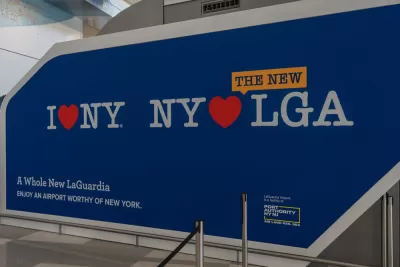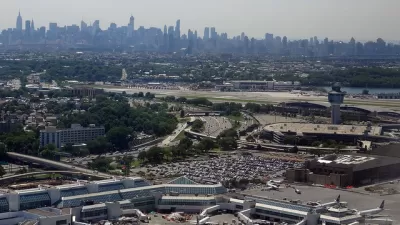After an $8 billion renovation, critics of the much-maligned airport claim the design is disjointed, while public transit access to the new terminals remains minimal.

In a piece for Bloomberg CityLab, James S. Russell describes the $8 billion renovation of “America’s most reviled airport,” New York’s LaGuardia.
Despite the massive investment in the modernization of the new terminals, the airport is, as Russell writes, “trapped in the husk of its reviled predecessor.” This is because “the ‘new’ LaGuardia’s expansion was constrained on a site that opened to pontooned flying boats and DC-3s in 1939. From the air, it looks like taffy pulled in several directions. Recently constructed buildings and roads had to dodge and weave among the detritus of boneheaded decisions past, including bits of the older terminals that had to remain in service as new ones were constructed.”
According to Russell, “Coherence and passenger-calming clarity in wayfinding have always been held sacrosanct by airport designers. But the new Terminal B — while a vast improvement that has been greeted with praise and was awarded the 2021 Prix Versailles, UNESCO’s annual architecture prize — is among the most idiosyncratic that air travelers are likely to encounter.” However, “Despite its busyness, the Terminal B pleases with its detailed focus on its users, from the new, roomier bathrooms to the unintimidating security checkpoint.” Russell goes on to describe Terminal C, designed by and for Delta to maximize efficiency and ease of experience for travelers.
The refreshed airport comes with another caveat: “Access to the airport is likely to continue to induce havoc, since there’s a lingering lack of roadway and parking capacity.” The airport continues to lack good access to public transit, and “ride-hailing services are accommodated as an afterthought.”
FULL STORY: The New LaGuardia Is Haunted by the Mistakes of its Past

Trump Administration Could Effectively End Housing Voucher Program
Federal officials are eyeing major cuts to the Section 8 program that helps millions of low-income households pay rent.

Planetizen Federal Action Tracker
A weekly monitor of how Trump’s orders and actions are impacting planners and planning in America.

The 120 Year Old Tiny Home Villages That Sheltered San Francisco’s Earthquake Refugees
More than a century ago, San Francisco mobilized to house thousands of residents displaced by the 1906 earthquake. Could their strategy offer a model for the present?

HSR Reaches Key Settlement in Northern California City
The state’s high-speed rail authority reached an agreement with Millbrae, a key city on the train’s proposed route to San Francisco.

Washington State Legislature Passes Parking Reform Bill
A bill that would limit parking requirements for new developments is headed to the governor’s desk.

Missouri Law Would Ban Protections for Housing Voucher Users
A state law seeks to overturn source-of-income discrimination bans passed by several Missouri cities.
Urban Design for Planners 1: Software Tools
This six-course series explores essential urban design concepts using open source software and equips planners with the tools they need to participate fully in the urban design process.
Planning for Universal Design
Learn the tools for implementing Universal Design in planning regulations.
Ada County Highway District
Clanton & Associates, Inc.
Jessamine County Fiscal Court
Institute for Housing and Urban Development Studies (IHS)
City of Grandview
Harvard GSD Executive Education
Toledo-Lucas County Plan Commissions
Salt Lake City
NYU Wagner Graduate School of Public Service



























